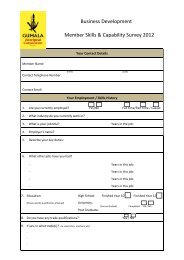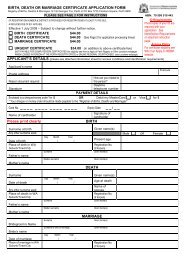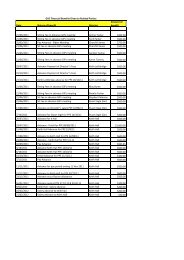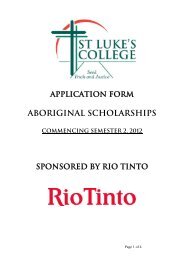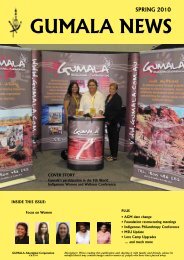Gumala News - Autumn 2010 Members Edition
Gumala News - Autumn 2010 Members Edition
Gumala News - Autumn 2010 Members Edition
You also want an ePaper? Increase the reach of your titles
YUMPU automatically turns print PDFs into web optimized ePapers that Google loves.
GUMALA NEWS AUTUMN <strong>2010</strong><br />
GUMALA NEWS AUTUMN <strong>2010</strong><br />
“If your <strong>Members</strong> are capable and are<br />
willing to work hard, they can have an<br />
employment future with us. We are very<br />
keen to get more traditional owners on<br />
board at Yandicoogina.” – Mark Rodgers, Rio Tinto<br />
Yandicoogina mine boss Mark Rodgers (right), pictured here alongside Darren Injie during a recent mine visit by the GAC<br />
Board of Directors and selected management and staff. Image courtesy of GAC Director Stephen Peterson.<br />
In Profile<br />
Mark Rodgers<br />
General Manager, Yandi Operations<br />
Rio Tinto<br />
<strong>Gumala</strong> Aboriginal Corporation is a key stakeholder in the massive iron ore mining operation at Yandicoogina. Image courtesy<br />
of GAC Director Stephen Peterson.<br />
When it comes to impressive track<br />
records and dedication at Rio Tinto,<br />
they don’t come any better than<br />
Mark Rodgers. The General Manager<br />
of the Yandicoogina (Yandi) mine -<br />
Australia’s largest-producing iron ore<br />
mine - and with 600-plus workers<br />
under his wings, Mark has dedicated<br />
half of his 22 year mining career to<br />
Rio Tinto.<br />
But, in a recent interview with<br />
<strong>Gumala</strong> <strong>News</strong>, the Scottish-born,<br />
energetic General Manager took<br />
time out to emphasis Rio Tinto’s<br />
strong relationship with <strong>Gumala</strong><br />
Aboriginal Corporation (GAC)<br />
and the mining giant’s continued<br />
commitment to employ more GAC<br />
<strong>Members</strong> at Yandicoogina.<br />
As all <strong>Members</strong> know, the historic<br />
Yandi Land Use Agreement secured<br />
by GAC in 1997 enabled the<br />
development of the Yandicoogina<br />
mine to proceed. That landmark<br />
agreement ensures that benefits are<br />
delivered to the Banyjima, Nyiyapali<br />
and Innawonga people for the life of<br />
the mine and beyond.<br />
Mark Rodgers has been General<br />
Manager of the Yandicoogina<br />
mine operations for three years,<br />
having been initially involved in<br />
Yandi during the development of<br />
the mine’s Junction South East<br />
expansion. He has previously<br />
managed the Marandoo and<br />
Brockman mines, and was the Study<br />
Manager at Brockman 4.<br />
Born in Glasgow and moving to<br />
Western Australia with his parents<br />
in the 1980s, the former mineral<br />
processing engineer has worked for<br />
22 years in the mining industry,<br />
including 11 years at Rio Tinto.<br />
“Our relationship with <strong>Gumala</strong>,<br />
which has been developing over a<br />
number of years, is very important<br />
to us,” Mark told <strong>Gumala</strong> <strong>News</strong>.<br />
“And we will continue to build on<br />
this relationship.<br />
“As both organisations have<br />
matured, the relationship has<br />
matured. I would describe the<br />
relationship we have with <strong>Gumala</strong> as<br />
very professional.”<br />
Mark said there are currently 23<br />
>><br />
>> full time indigenous employees at<br />
Yandicoogina, and Rio Tinto’s aim is<br />
to increase the number of traditional<br />
owners working at the mine.<br />
“If your <strong>Members</strong> have the relevant<br />
work experience, they should send<br />
in their resume to us. If they are<br />
capable and are willing to work hard,<br />
they can have an employment future<br />
with us.”<br />
Rio Tinto also has 10 indigenous<br />
trainees involved in a training<br />
program to get them work-ready,<br />
and is encouraging <strong>Gumala</strong> <strong>Members</strong><br />
to follow a similar path.<br />
“We are very keen to get more<br />
traditional owners on board at<br />
Yandicoogina,” Mark said.<br />
The Junction South East expansion<br />
in 2007 and 2008 has brought<br />
Yandicoogina’s nameplate annual<br />
capacity up to 52 million tonnes.<br />
Three plants operate at Yandi, with<br />
38 to 40 trains per week (each train<br />
carries 27,000 tonnes) transporting<br />
iron ore to Cape Lambert for export.<br />
Last December Yandicoogina became<br />
the first mine in Australia to produce<br />
50 million tonnes a year. This was<br />
a significant milestone, especially<br />
considering the global financial crisis,<br />
the slump in demand for iron ore<br />
in early 2009 and last year’s severe<br />
flood-damage to rail operations. Rio<br />
Tinto plans to open up new areas at<br />
Yandi, starting with Junction South<br />
West.<br />
Yandicoogina is situated in a rich<br />
channel iron deposit in the heart<br />
of the Pilbara. When the mine was<br />
commissioned in 1998, its capacity<br />
was 15 million tonnes per annum.<br />
Its first full year of operations<br />
produced 10.7 million tonnes.<br />
Yandicoogina ore is marketed<br />
separately from Rio Tinto’s Pilbara<br />
Blend and Robe River products.<br />
The pisolite ore is highly sought<br />
after by steel mills for its ability to<br />
improve the smelting of other ores.<br />
It is successfully marketed in Rio<br />
Tinto’s major Asian destinations,<br />
where its sinter-efficient properties<br />
enhance its value in use in smelting<br />
fines.<br />
Page 4 <strong>Gumala</strong> Aboriginal Corporation <strong>Gumala</strong> Aboriginal Corporation Page 5




